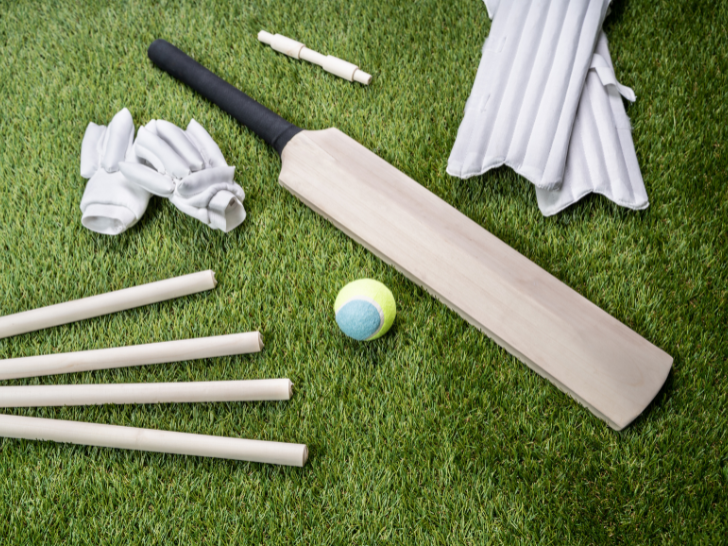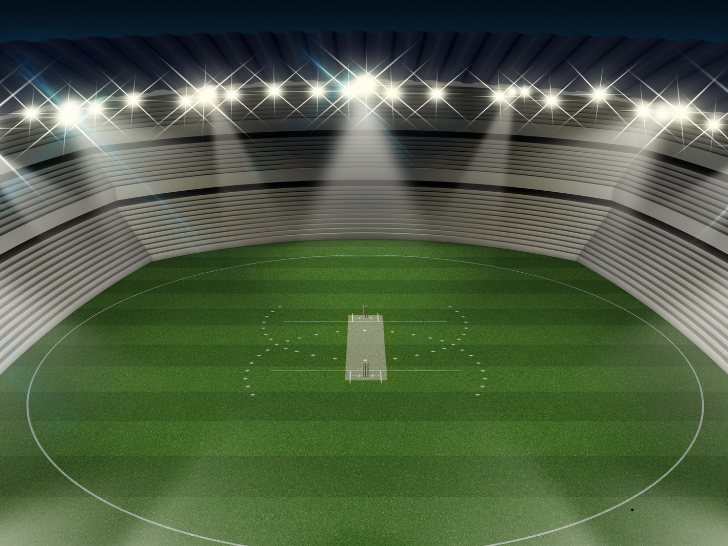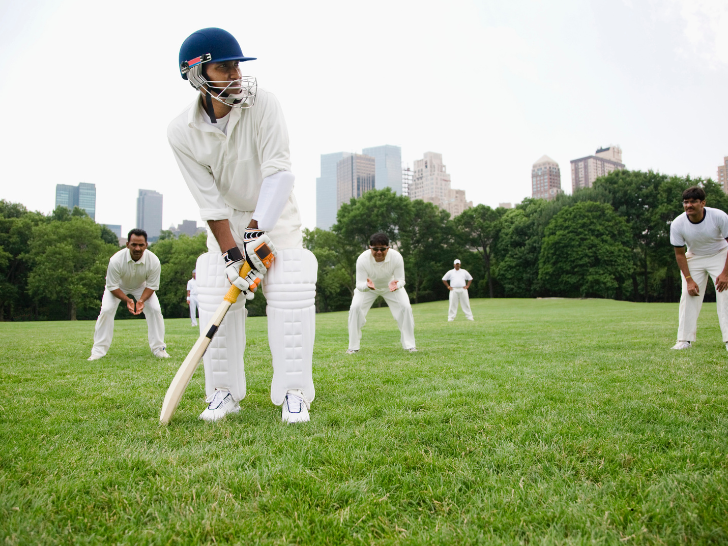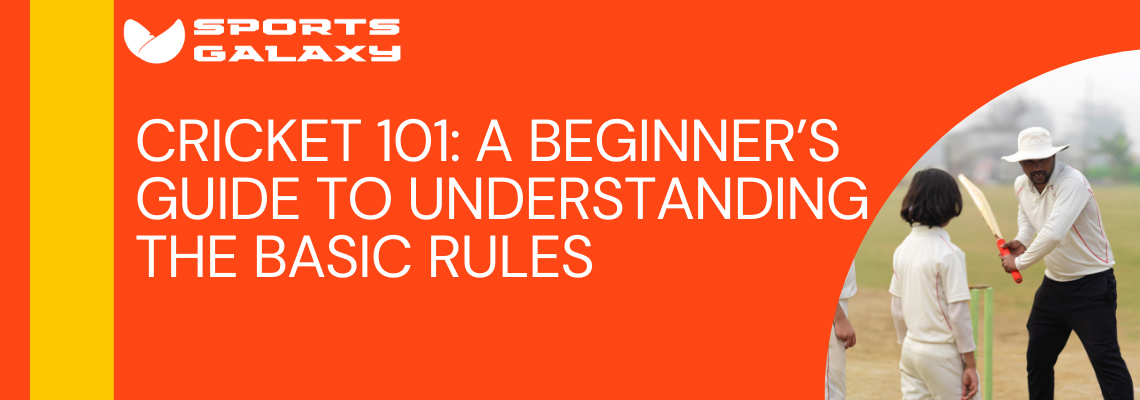Cricket might initially seem confusing, and matches can last from a few hours to several days. It’s an old game, played for more than 250 years. While cricket shares some similarities with baseball, the rules are quite different. This blog guide will help you understand the basic rules and concepts of cricket, but remember that some rules can be tricky at times.
Understanding the Equipment

1. Memorize the five basic pieces of equipment.
2. Know what the different pieces of equipment look like.
The ball is hard and covered in leather, and the bat is made up of wood and it is flat on one side and humped on the other. Stumps are wooden posts that are 32 inches high. Bails are the wood pieces that sit in grooves on the top of the stumps, and wickets are rectangular wooden structures made up of the stumps and Bails. There are 2 wickets each made from 3 stumps and 2 bails 1 set at each end of the main playing area known as a wicket. There are 11 players in both teams. 3 umpires are selected in the match where 2 umpires are at the ground and 1 is at out of the ground.
Look at pictures of the equipment online.
Watch professionals play cricket online or on sports channels on TV—you will see the equipment they are using.
Recognize where the equipment is used on the field: the bats and balls are in the players’ hands, but the wickets and stumps are out on the field.
3. Test out cricket equipment.
This is the easiest way to get really familiar with the components of cricket. Go to a local sports store and ask if they have cricket equipment. Look at the balls, bats, stumps, and wickets. Try handling them.
Understanding the Field

1. Memorize the different parts.
The cricket pitch is a field that a match is played on. the playing area is restricted by a rope around the edge known as the boundary rope. In the middle of that pitch is the rectangular area known as the wicket, where the main action happens, and you will normally find the two wickets described above, 1 at each end of this area. There are also White lines painted in front of the wicket to indicate the crease. [4]
- The wooden wickets are at either end of the wicket. The batsmen stand in front of these.
- The batsmen run in between these to score runs.
- Boundaries are the edges of the playing field.
2. Look at a diagram.
Just reading about the layout of a field can be confusing. Looking at a labeled diagram of a field can help you understand it. You can even try copying the diagram by hand to help you familiarize yourself with it. Knowing the parts of the field is essential to understanding the game and the rules. The fielders can stand at many different field positions including, on the silly point, gully, mid off, mid on, a third man, fine leg, slip, mid-wicket, long off, long, cover, short cover, forward short leg, backward short leg or leg slip, etc.
3.Watch a game.
You can attend a cricket game if you live near a field; if not, there are many online videos of games and it is a popular sport in many countries so is broadcast on television. Watch a few, and look at the marks on and layout of the field. See if you can name the different parts, such as the pitch and wicket.
Understanding the Players

1.Know about the batsman.
The team that is batting sends two players to bat at a time, and these are called batsmen.[5] They wear protective gear and carry cricket bats. Each batsman wants to score as many runs as possible without getting out. To score runs, you either run between the wickets, or you hit the ball over the boundary.
- One type of boundary is awarded four runs. This is when the batsman hits the ball past the boundary line even though the ball has touched the ground inside the boundary rope.
- The other type of boundary is awarded six runs. This is when the batsman hits the ball past the boundary line without the ball bouncing first.
2.Learn about the fielding team.
On the field are the eleven fielding players. One is a bowler who stands at one end ready to deliver a ball; one is a wicket-keeper who is behind the other wicket ready to catch a ball that is missed by the batsman. This players has special gloves on.
- The other 9 players have no special equipment.
- The other 9 players are the stand in various locations around the field.
- Their collective goal is to stop the batsman from scoring runs, and get them out.
3.Understand innings.
An innings in cricket means 1 team is bowling and fielding, and the other team is batting, When a team is batting, it is known as their inning. The players switch roles when an innings is over.
Understanding Gameplay

1.Know the basic concept of the game.
Cricket involves two teams of eleven players each.Teams bat in successive innings and try to score runs; the opposing team is in the field and trying to end the batting team’s innings by getting 10 of them out. There are several different ways to get a batsman out and getting a batsman out is referred to as taking their wicket. After the two teams have batted (one or two innings depending on the format of the game) the team with the most runs wins. The basic concept of cricket is as simple as that!
2. Familiarize yourself with the sequence of events.
A coin toss decides which team bats or fields first. The two batsmen in the middle of the pitch need to make runs by hitting the ball, and the bowler will try to bowl them out. The batsmen take turns hitting the ball and running to the opposite wicket, trying to ensure they get their runs before the fielder throws the ball back.
- If a bowler, delivers a ball and the ball hits the stumps and the bail falls off, he is out Bowled.
- If a batsman hits the stumps with his bat and the bail falls off, he is out hit stumps.
- If a batsman is hit by the ball on the legs, and it is judged that the ball would have gone on to hit the stumps, he is out leg before wicket.
- If a fielder, bowler, or wicket keeper catches the batsman’s hit, he is out caught.
- If the batsman is running and the fielder, bowler, or wicketkeeper throws the ball directly at the batsman’s stumps and the bail falls off before the batsman is inside the crease, he is out run out.
- If a batsman is out another batsman replaces him.
- Once a team has lost ten wickets the innings is finished.
3. Know a few basic things to do.
If a player is batting, they should run between the wickets until the fielders have their ball; in cricket, batsmen can score multiple runs per shot. If a player is in the field, they should pay attention to the bowler and batsmen so they will be ready to catch the ball when and if it comes at them. When a fielder collects a ball, they must decide to throw it back to the bowler or the wicket keeper, depending on where there is a higher chance to get a batsman out.
4. Know a few basic things that go against the rules.
For example, a player can’t bowl the ball from an undesignated area, or aim the ball directly at batsmen. These are all actions that go against the rules of cricket. There are many other things a player cannot do, such as:
- Touching the ball when batting.
- Bowl the ball that bounces too many times before reaching the batsman.
- Bowl the ball too far to either side of the wicket they are aiming at.
- Hitting the ball twice when batting.
- Batsmen need to be paying attention while batting, or they can get out.



